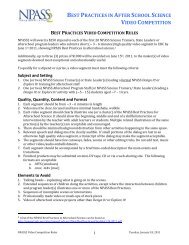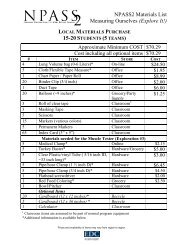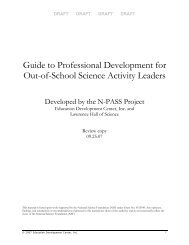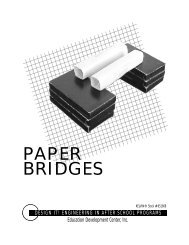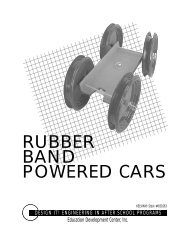STRAW ROCKETS - NPASS2 - Education Development Center, Inc.
STRAW ROCKETS - NPASS2 - Education Development Center, Inc.
STRAW ROCKETS - NPASS2 - Education Development Center, Inc.
Create successful ePaper yourself
Turn your PDF publications into a flip-book with our unique Google optimized e-Paper software.
<strong>STRAW</strong><br />
<strong>ROCKETS</strong><br />
KELVIN® Stock #651816<br />
DESIGN IT! ENGINEERING IN AFTER SCHOOL PROGRAMS<br />
<strong>Education</strong> <strong>Development</strong> <strong>Center</strong>, <strong>Inc</strong>.
Design It! Engineering in After School Programs<br />
Table of Contents<br />
Overview ........................................................................................3<br />
Activity 1: The Basic Straw Rocket ......................................11<br />
Activity 2: Rocket Launcher ..................................................23<br />
Activity 3: Book Drop ..............................................................37<br />
Activity 4: Launch Position ....................................................47<br />
Activity 5: Fins ..........................................................................55<br />
Activity 6: Rocket Length (optional)....................................69<br />
Activity 7: Play a Rocket Game ............................................77<br />
Appendix......................................................................................87<br />
Resources........................................................................89<br />
Images ............................................................................90<br />
Rocket ..................................................................................................90<br />
Angle Template ..................................................................................91<br />
Protractor............................................................................................91<br />
Planet Targets ..................................................................................92<br />
Data Sheet ....................................................................93<br />
Letter to Families ........................................................97<br />
Kelvin Materials Order Form ....................................99
Overview<br />
Overview<br />
Rockets have fascinated generations of people.<br />
From the firework rockets that the Chinese created<br />
centuries ago, to the first rocket to land on the<br />
moon, to our latest Mars explorers, we have<br />
invested a lot of energy into designing more and<br />
more sophisticated rockets. Though we find new<br />
ways of powering and building rockets, the basic<br />
principles of what they do is the same. In this<br />
Design It! project, children have the opportunity to<br />
design their own launchers and straw rockets<br />
while experiencing these basic principles.<br />
Figure O.1<br />
Straw rocket.<br />
Made from drinking straws, the simple rockets of these activities can captivate children for hours. With<br />
just a push of air, the rockets are propelled into “space.” The children will work together, troubleshooting<br />
and problem solving, until they create the optimum rocket and launching system. Their learning and<br />
designs are tested when the children play a rocket game.<br />
As the children work through the challenges in this project, they will learn about experimenting, testing,<br />
making observations, asking questions, and explaining what they have done and why they did it—the<br />
essential elements of critical thinking and the inquiry approach to engineering and science.<br />
MATERIALS<br />
The materials recommended for this project have been tested by children ages 8–12 years. Most of the<br />
materials are generic in type, so virtually any brand will work as well as another. Generally, you should not<br />
give alternative materials to the children until you have tested them yourself.<br />
Below is the master list of the materials children will need to complete all of the activities in this project.<br />
Each particular activity contains a list with amounts specific for that activity. Items marked with a [*] are<br />
available directly from Kelvin (see order form on page 99).<br />
For each team<br />
• 1–2 books (hardcover, 8 x 9 inches or larger,<br />
weighing around 2 pounds)<br />
or 5 magazines and 2 pieces of 8 x 11-inch<br />
cardboard<br />
• 2 rubber bands<br />
• 1 cardboard box (11 x 11 x 12 inches or larger)<br />
• 9 jumbo (wide) straws<br />
• 1 marker (permanent, dark colored)<br />
• 1 pair of scissors<br />
• several pieces of copy paper<br />
• 2 launching assemblies made from:<br />
– 1 resealable (slider) plastic freezer bag<br />
(quart-size)<br />
– 1 yard of duct tape<br />
– 1 yard of plastic tubing<br />
– 1 regular drinking straw<br />
• 1 roll of masking tape (1-inch wide)<br />
• 1 measuring tape or yardstick (optional)<br />
• 1 pad of self-adhesive notes, such as Post-its<br />
(1-1/2 x 2 inches)<br />
• cellophane tape<br />
• index cards (5 x 7 inches)<br />
Straw Rockets<br />
Overview<br />
3
Overview<br />
For the whole group<br />
• colored markers<br />
• extra straws<br />
• pencils and pens<br />
• extra resealable (with slider) plastic freezer bags<br />
(quart-size)<br />
• protractors (optional)<br />
• protective eyewear<br />
For the program leader<br />
• rocket images (page 90)<br />
• angle template (page 91)<br />
• planet targets (page 92)<br />
• duct tape<br />
• chart paper<br />
• graph paper, yardsticks, paper bags<br />
(optional)<br />
BOOKS<br />
Choose hardcover books or collect magazines and place them between two pieces of rigid cardboard and<br />
secure them with rubber bands. Make sure that whatever you use is not heavier than three pounds. It is<br />
important that the children do not easily pop the resealable bags.<br />
CHART PAPER<br />
You will use chart paper throughout the project to create lists and group data sheets during discussions<br />
for all children to see. It is not listed in each activity’s materials list. Chart paper can be purchased at<br />
office supply stores.<br />
MEASURING TAPE<br />
A measuring tape is only one option for measuring the length of the rockets’ flights. As an alternative,<br />
you may create homemade measuring string on which you have marked each increment of a foot. You<br />
can also use yardsticks or count floor tiles.<br />
RESEALABLE PLASTIC FREEZER BAGS<br />
Choose resealable bags with a safety lock—also known as<br />
“slider bags” (see Figure O.2)—because they are easier for<br />
children to close than regular resealable bags. To help with the<br />
problem of bag breakage, it is best to choose a sturdy brand of<br />
freezer bags.<br />
Figure O.2<br />
Resealable plastic freezer bag.<br />
<strong>STRAW</strong>S<br />
Both regular and jumbo straws are needed for this activity. Jumbo<br />
straws are the type used for thick drinks, such as frappes and<br />
milkshakes. Movie theaters, coffee houses, and ice cream servers<br />
often have them. If you cannot find jumbo straws, use thin<br />
straws with regular straws or try making your rocket by tightly<br />
rolling a rectangular strip of paper around a pencil. Secure the<br />
paper with tape (Figure O.3). Check for and repair air leaks<br />
with additional tape.<br />
TUBING<br />
Clear, flexible vinyl tubing is available in a variety of<br />
diameters, both inner and outer. Make sure that the straws you<br />
use for the launchers fit snugly into the tubing you purchase.<br />
Figure O.3<br />
(1) Wrap a thin piece of<br />
paper around a pencil. Tape<br />
the paper near both ends.<br />
(2) Remove the paper from<br />
the pencil. Cut off the extra<br />
paper so the ends are<br />
straight.<br />
4<br />
Straw Rockets<br />
Overview
Overview<br />
The standard inner diameter (ID) of regular straws is 1/4 inch. Therefore, if you buy tubing with an ID<br />
of 1/4–5/16 inch, you should have no problems fitting them together. The outer diameter (OD) of the<br />
tubing does not matter for this activity. Tubing is available at most hardware stores in the plumbing<br />
supply section.<br />
TEAMWORK<br />
It is recommended that you divide the children into teams of two to four children who will work<br />
together as a team for a number of weeks. Try to make sure that the natural skills and energy of your<br />
whole group are shared evenly among these teams. If you allow teams of children who are already good<br />
friends, be aware that some children may, thereby, be shut out of participation in the project. If practical,<br />
mix girls and boys and older and younger children. Be flexible and open to re-teaming the children from<br />
time to time if the first groupings are not working well, or simply to ensure that the children experience<br />
new working partners that they might not have chosen on their own.<br />
Defining roles<br />
Within the teams, it is recommended that you assign one or more specific role(s) to each child for the<br />
design work. Assigning roles can have a number of beneficial effects:<br />
• Each child knows exactly what is expected of him or her and learns how to share the fun and<br />
responsibility of the work fairly with others.<br />
• More introverted or timid children get equal access to the materials along with more assertive<br />
children.<br />
• Children who might otherwise disengage are given important tasks that demand their involvement.<br />
• Tasks that might normally fall by the wayside are remembered and accounted for.<br />
Here are some roles you might use:<br />
BUILDER: Connects the pieces of the launcher and rocket together. All team members are builders all the<br />
time, unless they are actively fulfilling another role.<br />
CHIEF ENGINEER: Directs the team effort. Settles disputes between other team members. Measures the<br />
length of each shot and keeps records. Responsible for ensuring that all materials are used safely.<br />
Other roles that should be shared among all the team members are listed below. Remember that each<br />
child may have more than one role.<br />
BOX HOLDER: Holds the box in position while the rocket is being launched.<br />
BAG BLOWER-UPPER: Blows up the plastic bag prior to launching.<br />
NOTE: So that germs are not spread, the bag blower-upper must continue in this role until a new<br />
launching straw is put into the tube.<br />
BOOK DROPPER: Drops the book onto the plastic bag for launching.<br />
ROCKET POSITIONER AND RETRIEVER: Places the rocket in position for launching and retrieves it after it<br />
has been launched.<br />
MATERIALS COORDINATOR: Collects initial materials for the project from the program leader. Checks all<br />
materials to ensure they are working properly. Searches for additional materials that can solve problems<br />
as they come up.<br />
Straw Rockets<br />
Overview<br />
5
Overview<br />
AMBASSADOR: Collects ideas from other teams by watching what they are doing and talking with them<br />
about their designs.<br />
PRESENTER: Presents the experience and the findings of the team to the whole group. Responsible for<br />
knowing what each team member thought or contributed to the design and construction process.<br />
Watch out for children who dominate their team and exclude others from the process, as well as for<br />
children who disengage. To help ensure that everyone remains engaged and has a fair chance to<br />
participate, restate the job descriptions at the beginning of each session and be sure the children know<br />
who is officially assigned to each role for that period of time. Roles should be switched at least at the<br />
beginning of each session, and possibly in the middle as well.<br />
MANAGEMENT OF THE ACTIVITIES<br />
Pacing<br />
The activities in this project are broken into manageable challenges so the children are able to have<br />
success without getting frustrated. As they proceed through one activity after another, they will be able<br />
to make the rockets fly farther and more accurately. This gradual improvement keeps children motivated<br />
to test and problem solve. Try to keep the children from going ahead or they may burn out quickly or get<br />
over stimulated and start to experience problems. The goal is for the children to methodically work<br />
through the steps of problem solving and to pay attention to the lessons learned from “unsuccessful”<br />
experiments.<br />
Competition<br />
Although competition can be highly motivating for children, it can also alienate some—usually those<br />
who are “losing” and, perhaps, those who are already most in danger of disengaging. Monitor the<br />
children’s language and behavior constantly to ensure that they are not making others feel<br />
uncomfortable, and if you decide to have formal competitions in this project, watch out that “winning”<br />
does not take over from all the other valuable aspects of this process. Explain that although scientists<br />
and engineers do compete, they more often work together to find the answer to a problem. The goal here<br />
is for the whole group to learn from each other about what works and what doesn’t when designing and<br />
constructing rockets and launching systems.<br />
Optimization<br />
In the real world, there are always cost constraints and physical limits to the performance of any device<br />
being designed. The solution design engineers look for is called the optimum arrangement—the<br />
arrangement that does the best job possible given the limitations of cost, space, or the nature of the<br />
materials available. After extensive testing, engineers choose the type and quantity of materials that<br />
come closest to fulfilling the requirements of the project. Another way of putting this is to say that there<br />
are seldom perfect solutions to an engineering problem.<br />
Using a set group and amount of materials, children will need to manipulate straw weight and length, fin<br />
design, and launching force and angle to create the optimum rocket system that will land a rocket on a<br />
chosen target. Use your own judgment about whether you introduce the term and the concept of<br />
optimization explicitly with the children. What is most important is that they learn to make the kinds of<br />
judgments and compromises mentioned and that they notice that the “best” amount of some factor is not<br />
always the largest amount possible.<br />
6<br />
Straw Rockets<br />
Overview
Overview<br />
TROUBLESHOOTING<br />
Children usually do not have much trouble assembling the suggested materials into a working rocket<br />
and launcher, but if they perform poorly, their first impulse may be to blame the materials or to blame<br />
themselves. Many children are convinced that they are just “no good at making things” or “no good at<br />
engineering.” Your task is to encourage them to search out the cause of the problems in the device itself,<br />
looking carefully at the specific ways that the materials are combined. Blaming oneself never helps, but<br />
it may take repeated reassurances and successes before some children buy into the idea that it really is<br />
about the materials and not about some quality that they, themselves, do not possess.<br />
Isolating where (in the materials) the problem is and either adjusting the materials or coming up with<br />
alternatives is much of what engineers and designers do. So, the tendency to blame the materials is<br />
constructive as long as it leads the children to look more closely at the device itself to locate the problem.<br />
In some situations, the solution to solving a problem may not be readily apparent. Try not to offer hints<br />
or solutions until the children have made some attempts to experiment with their designs. Three (kinds<br />
of) questions may help you stimulate their thinking and energy:<br />
• What have you tried (and what happened)?<br />
• What works (and what doesn’t)?<br />
• What has worked for other teams? (Has the ambassador been looking at what other teams have<br />
been doing?)<br />
After repeated attempts, children may be ready to give up. If this point arrives, offer a hint or clue that<br />
will get the children over the hump and allow them to resume being successful with the device. The<br />
Guiding the Activity section of many activities offers suggested solutions to common construction and<br />
design problems.<br />
DISCUSSION<br />
The guidelines for each Design It! activity suggest that you hold a formal discussion with the children at<br />
some point during each session of hands-on work. It is recommended that you create a Discussion<br />
Circle, where children are away from their materials, sitting in a circle or group, to talk about what they<br />
have achieved or noticed so far. If you or the children are new to this format, this discussion time need<br />
not be very long, but it should become a regular part of your Design It! routine from the very beginning.<br />
The importance of “talk”<br />
When children talk about what they are doing they discover much more about the project than if they<br />
only do the hands-on portions. When they talk, children have to reflect not only on what they did, but<br />
also on how they did it. They have to think about their actions and about their thinking.<br />
Talking openly about how they solved (or didn’t solve) a problem serves several useful functions for<br />
children. It allows them to:<br />
• share and celebrate what they know and what they have succeeded in doing,<br />
• acknowledge what they don’t know and what they cannot succeed in doing,<br />
• hear what other people thought or did in a similar situation, and<br />
• piece together their thinking (about engineering solutions or decisions) in a way that they are not yet<br />
experienced enough to do for themselves.<br />
Straw Rockets<br />
Overview<br />
7
Overview<br />
It is very important that these discussions be a positive experience for the children, a chance for them to<br />
share, think out loud, and feel good about their contributions. Avoid calling only on the articulate<br />
children or the first to respond. Try also to make time for the less verbal children to say what they can<br />
about their experiences. Avoid telling a child that he or she is either “right” or “wrong” about something;<br />
it closes the door for other ideas and approaches from that child or other children. Thank and praise<br />
children for contributing in a respectful and thoughtful way. Sharing ideas should be its own reward—it<br />
is not a way to show who is right and who is not.<br />
?<br />
Specific questions are often suggested to help you lead your discussions. A question mark icon, as<br />
shown here, will help you identify where these questions are located in the text.<br />
The importance of “non-talk”<br />
Discussions during this project will strengthen the children’s language skills. However, there are other<br />
ways to communicate and explain that do not use words. Throughout the discussions, encourage<br />
children to use hand signs, drawings, made-up words, and other creative strategies to get their points<br />
across.<br />
ASSESSMENT<br />
The most direct assessment of the children’s work in this project is their ability to make rockets and<br />
launchers that work. If they are careful in their technique of assembling parts and launching, and if they<br />
think through problems deliberately, they should be successful.<br />
It is important to observe each team over the series of sessions and note how they proceed with the more<br />
difficult challenges. As you observe, ask yourself whether you see a gradual increase in the children’s<br />
ability (or willingness) to:<br />
• think through their designs and deal with problems in a skillful manner,<br />
• work cooperatively (i.e., share their work and listen to each other’s ideas and suggestions),<br />
• describe to you and to each other how they did whatever they did and why it worked, and<br />
• focus on what they actually see happening rather than what they think should happen.<br />
Specifically, look for increases in these behaviors:<br />
• Taking turns and sharing the hands-on work.<br />
• Asking each other for help before asking you.<br />
• Listening when their peers are sharing ideas.<br />
• Responding constructively to ideas from peers or adults.<br />
• Making deliberate changes to their designs to improve how they work.<br />
• Making these changes to only one factor at a time.<br />
• Keeping accurate and clear data and records.<br />
Where appropriate, more specific suggestions for carrying out assessment are given in the Background<br />
section of the activities (Activity 7 offers assessment suggestions in Guiding the Activity).<br />
8<br />
Straw Rockets<br />
Overview
Overview<br />
SPACE<br />
Work space<br />
For these activities, each team needs a launch area (runway) at least 18 feet long and 3 feet wide. Teams<br />
may share a runway, but each team must have sole use of the runway when they are launching. Push<br />
furniture to the side if needed. If space is limited, you might consider adjusting the activity. Have the<br />
teams aim at targets that are within the distance that you have available. You can also measure the<br />
vertical distance (how high the rockets hit on a wall) rather than the horizontal distance that they travel.<br />
Storage<br />
You will need a place to store the launch boxes (which are also used to hold the children’s materials).<br />
SAFETY<br />
With clear expectations and rules communicated to children, followed with normal supervision, there is<br />
no reason Straw Rockets cannot be used safely by your children. Work with the children to establish<br />
safety rules that include the following:<br />
• Only launch rockets away from people.<br />
• Wait until your runway is clear of people to launch your rocket.<br />
• Wear protective eyewear.<br />
• Use materials only in the manner they are meant to be used in the activity.<br />
SAFETY<br />
Safety messages appear throughout the activities when necessary.<br />
You will be able to find them easily by looking for the safety icon at<br />
left.<br />
IMPLEMENTATION GUIDE<br />
The above issues and procedures are developed in more detail in a separate publication called The<br />
Implementation Guide for Design It! Projects. It is strongly recommended that you purchase this guide<br />
and consult it before carrying out any Design It! project with your children.<br />
Straw Rockets<br />
Overview<br />
9
Challenge Sheet<br />
ACTIVITY<br />
1<br />
Activity 1: The Basic Straw Rocket<br />
What Materials Do I Have?<br />
• 2 regular straws<br />
• 2 lengths of jumbo straws (4-inches long)<br />
• masking tape<br />
• pencil<br />
• paper clips<br />
• measuring tape (optional)<br />
• Data Sheet<br />
THE CHALLENGE<br />
Use your breath and a straw to launch a straw rocket 6 feet or more.<br />
What Do I Do?<br />
1. Using the available materials, create a rocket out of a straw.<br />
2. Figure out a way to launch the rocket using your breath and the materials that you<br />
have. How far can you make the rocket travel?<br />
3. Be sure to write your name on your straw rocket and your launching straw.<br />
What to Think About<br />
• What will make the rocket fly farther?<br />
• What can you change to make the rocket fly differently?<br />
SAFETY:<br />
• Only launch rockets away from people. Wait until the floor is clear before you launch<br />
your rocket.<br />
• When you pick up your launched rocket, make sure that no one else is launching in<br />
your direction.<br />
Straw Rockets<br />
Activity 1: The Basic Straw Rocket<br />
11
Activity 1: The Basic Straw<br />
Rocket<br />
ACTIVITY<br />
Guiding the Activity<br />
1<br />
PREPARING AHEAD<br />
• Read through the complete guide so you know the goals of each<br />
challenge.<br />
• Decide who will be in each team of two.<br />
NOTE: In later activities, you may combine teams of two to create<br />
teams of four.<br />
• Decide where you want each team to stand when they launch their<br />
rockets. Mark those spots with tape. From there, if the children do not<br />
have floor tiles or another way of keeping a record of how far the rockets<br />
travel, use tape to mark off one-foot increments on the floor in the<br />
direction that you want the children to launch their rockets.<br />
(Alternatively, the children may do their own measuring.)<br />
• Gather the materials that each team will need. Be sure to have enough<br />
straws so that each child can make and launch his or her own rocket.<br />
Have extra straws available.<br />
• Make and test a rocket yourself. (During this activity, the children are<br />
challenged to design a rocket and launching procedure as outlined below.<br />
Let them figure out an arrangement by themselves as much as possible<br />
before giving them any directions.)<br />
1. Using tape, close one end of one of<br />
the wide, short straws (Figure 1.1).<br />
2. Place the short straw over the thin<br />
long straw (Figure 1.2).<br />
3. Blow into the long straw. The short<br />
straw will launch into the air (Figure<br />
1.3).<br />
4. Turn over 1/2 inch of the end of another<br />
short straw (Figure 1.4). Tape the bent end<br />
in place. Test this rocket.<br />
Materials<br />
FOR EACH TEAM<br />
• 2 regular straws<br />
• 4 lengths of jumbo<br />
straws (4-inches long)<br />
• masking tape<br />
• pencil<br />
• paper clips<br />
• measuring tape<br />
(optional)<br />
• Data Sheet<br />
FOR THE WHOLE GROUP<br />
• extra straws<br />
Figure 1.1<br />
Straw rocket with taped end.<br />
Figure 1.2<br />
Straws placed together to launch.<br />
Figure 1.3<br />
Launching the straw.<br />
Figure 1.4<br />
Bent straw rocket.<br />
Straw Rockets<br />
Activity 1: The Basic Straw Rocket<br />
13
1<br />
ACTIVITY<br />
Guiding the Activity<br />
• Make one copy of the Challenge Sheet and the Data Sheet (page 93)<br />
for each team.<br />
• Copy the Letter to Families (page 97) and send one home with<br />
each child.<br />
INTRODUCING THE ACTIVITY<br />
Gather the children together and tell them that they will design, construct,<br />
and test straw rockets and launchers during this project. At the end of the<br />
project, they will play a game during which they can apply all that they have<br />
learned while launching their rockets at targets.<br />
?<br />
Ask the children:<br />
• How many of you have made rockets before. What do you know about<br />
rockets from this experience?<br />
• How many have seen a real rocket launch from earth? What did you<br />
notice?<br />
• How are rockets different from planes?<br />
• Have you ever built paper airplanes?<br />
THE CHALLENGE<br />
Use your breath and a straw to launch a straw rocket 6 feet<br />
or more.<br />
?<br />
Explain the first challenge and introduce the materials available. Each child<br />
should begin with two straws (one thin, long straw and one wide, short<br />
straw) and tape.<br />
• What do you think you need to do to create a rocket and launcher out of<br />
these materials?<br />
• How will you launch the rocket with your mouths?<br />
Have children brainstorm ideas to answer these questions.<br />
Let the children know that you will assign them to teams of two. Team<br />
members will share ideas, help each other test their rockets and record<br />
results, alternately launch rockets, and complete one Data Sheet as a team.<br />
Their goal together, not individually, is to successfully meet the challenge;<br />
however, each child will use his or her own launch straw.<br />
Show the group the Data Sheet and discuss what information they need to<br />
record and how to record it. Each time one of the team members launches a<br />
rocket, the other member of the team should measure the distance that the<br />
rocket traveled (measuring from the tip of the launcher’s feet to the point<br />
where the nose of the rocket first touched the ground) and record that<br />
measurement under the heading “Distance Rocket Traveled.” After a rocket<br />
14<br />
Straw Rockets<br />
Activity 1: The Basic Straw Rocket
has been launched and the data recorded, the team members should switch<br />
roles. Now the other person launches their rocket and their teammate<br />
measures and records the distance it traveled. Describe to the children the<br />
different ways they can measure distance from where they launch to where<br />
the rocket lands.<br />
ACTIVITY<br />
Guiding the Activity<br />
1<br />
Discuss the safety guidelines:<br />
• To ensure that germs are not spread through the children’s saliva,<br />
each team member should touch only his straw with his mouth. Make<br />
sure they put their names on their rockets ahead of time.<br />
• Children should only launch rockets away from people, and must wait<br />
until the floor is clear before they launch a rocket.<br />
• When measuring the distance that a rocket has traveled and/or<br />
picking up a launched rocket, children must make sure that no one<br />
else is launching in their direction.<br />
SAFETY<br />
Let the children know that you will gather them together after they have<br />
worked for a while to demonstrate their rocket flying and to discuss what<br />
they did and what they noticed.<br />
Just before starting the activity, give the children a specific amount of time to<br />
launch their rockets before coming together for discussion, put the teams<br />
together, pass out the Challenge Sheets and Data Sheets, and set the children<br />
to work.<br />
LEADING THE ACTIVITY<br />
How will the children make and launch the<br />
straw rocket? If they put the wide straw onto<br />
the narrow straw and blow, they will notice<br />
that the wide straw does not move (Figure<br />
1.5). They must figure out that the end of<br />
the wide straw must be closed for the rocket<br />
to perform.<br />
Figure 1.5<br />
Straw doesn’t move if end is open.<br />
Figure 1.6<br />
Closed end enables air pressure to move straw.<br />
If they close one end of the wide straw and<br />
then place it on the narrow straw, the<br />
increased air pressure will propel the rocket<br />
forward (Figure 1.6).<br />
If the children start to become frustrated,<br />
walk around to teams with the wrapper of a<br />
straw opened on one side but still covering<br />
the straw. Blow into the open end of the<br />
straw. The wrapper should shoot off the<br />
straw (Figure 1.7). (If it does not, you may<br />
need to tear away a bit more of the wrapper<br />
from the end.)<br />
Figure 1.7<br />
Straw wrapper sails away.<br />
Straw Rockets<br />
Activity 1: The Basic Straw Rocket<br />
15
ACTIVITY<br />
1<br />
Guiding the Activity<br />
Without saying anything, see if the children can translate what they have<br />
observed about the straw wrapper demonstration into bettering the<br />
performance of their own rockets. Carry extra straws with wrappers so that<br />
you can repeat the demonstration as needed. If the children still do not catch<br />
on, ask them what they notice about the wrapper.<br />
If they do not point out that one end is closed, open that end and then blow.<br />
When it does not move, ask them what happened. Then have them think<br />
about how they can apply what they just saw to their own rockets. If you<br />
have many straws with wrappers, you can give them to the children to do the<br />
experiment themselves rather than showing them.<br />
The straw wrapper demonstration should give the children a hint about how<br />
to launch the rocket, since the wrapper fits over the straw in the same way<br />
that the jumbo straw fits over the regular sized straw. Perhaps some children<br />
have tried holding the rocket directly in their mouths (i.e., without using the<br />
long straw as a launcher) and blowing through it while releasing their grip on<br />
it. This method does not work very well. Ask them how they can use their<br />
breath without directly holding the straw rocket in their mouth. Sliding the<br />
wide straw over the narrow straw and blowing into the open end of the<br />
narrow straw works well. They can see this from your demonstration.<br />
As you walk around the room, make sure that each team is using the<br />
materials safely and taking turns. Encourage them to notice differences<br />
between each rocket flight. When they notice a change, ask them what was<br />
different in the rocket, the environment, or in their launching procedure that<br />
could have caused the difference. Encourage the teams to try and make their<br />
rockets hit a target.<br />
Check that teams are recording the measurements of the flight of their<br />
rockets on the Data Sheet. Children should be measuring from the tips of<br />
their shoes to the spot where the rocket first touches the ground. Teams can<br />
use a measuring tape, the strips of tape you’ve put on the floor, or floor tiles,<br />
if you have them. Counting floor tiles does not give a perfectly accurate<br />
measurement, but it may be easier for children who cannot easily use and<br />
read a measuring tape.<br />
When teams use tape or a paper clip on their rockets, weight is added. Ask<br />
the children if the weight makes a difference in the flight of the rocket. Does<br />
the placement of the weight make a difference? Challenge the children to test<br />
their rockets with extra weight so that they can answer this question.<br />
When every child has experimented launching a rocket with varying amounts<br />
of breath, launch angle, and weight, stop them from working. Ask the<br />
children, one at a time, to demonstrate for everyone how their rockets fly. As<br />
the rockets fly, ask the whole group to notice how each demonstrator<br />
launches the rocket, how the rocket travels, and where it lands.<br />
16<br />
Straw Rockets<br />
Activity 1: The Basic Straw Rocket
Before coming together for a Discussion Circle, have the children store their<br />
rockets in an area designated by you. Make sure they have marked their<br />
names on their rockets.<br />
LEADING THE DISCUSSION<br />
Ask the children what they noticed during the demonstrations and their<br />
testing:<br />
• What distances did your rockets fly?<br />
• Did your rockets fly straight?<br />
• Were you able to hit the same target several times?<br />
• What could have made the rockets fly differently each time?<br />
• Were any of the rockets designed differently?<br />
• Did you close the end of your rocket in the same way?<br />
• Did you use tape or bend the end of the straw over?<br />
• How much tape did you use?<br />
• What difference might these variations make in the flight of the<br />
rocket?<br />
• What difference did the paper clip make in the flight of the rocket?<br />
• Did the rocket fly straighter or farther with the paper clip in a<br />
certain spot?<br />
?<br />
If the group comes to an agreement that a weight at the front tip of the rocket<br />
is best, show them the trick of bending over 1/2 inch of the end of the straw.<br />
In any case, let the teams keep their rockets as they designed them, if they<br />
prefer, for the next activity.<br />
If during this discussion children do not mention the amount of air blown<br />
into the straw by the launcher, the rate at which the air was blown (e.g., a<br />
gentle puff or a strong burst), the height of the launcher, or the angle at<br />
which they launched the rocket, then bring up these ideas as questions.<br />
• Do these factors make a difference?<br />
• How can you find out?<br />
• How can you know which things make a difference and which do<br />
not?<br />
?<br />
During the next activity, the children will design rocket launchers that will<br />
enable them to change just one thing at a time so they can test what makes a<br />
difference in the rocket’s flight. When the children use their breath to launch<br />
the rockets, there is no way to control all of the factors mentioned, even if<br />
only one child launches each time, and height and angle are controlled.<br />
Wrap up the conversation by trying to summarize the children’s findings and<br />
establishing what the optimum straw-rocket design and launching procedure<br />
are up to this point.<br />
ACTIVITY<br />
Guiding the Activity<br />
1<br />
Straw Rockets<br />
Activity 1: The Basic Straw Rocket<br />
17
ACTIVITY<br />
Background<br />
1<br />
Activity 1: The Basic Straw<br />
Rocket<br />
RATIONALE<br />
During this activity, the children use their bodies to gain an intuitive sense of<br />
what goes on when their straw rockets are launched. They use simple<br />
materials to focus on what is needed to turn the straw into a projectile that<br />
will launch with a blow of air. By the end of the activity, they will notice<br />
variations in the flight of the rockets, caused by many things: (1) lack of a<br />
consistent source of power children cannot control the exact amount of<br />
breath they use each time they launch their rockets), (2) the height of launch<br />
(children launch from different heights based on how tall they are), (3) and<br />
the angles of launch. In the next activity, the children have the opportunity to<br />
design a launching system that provides a consistent launch.<br />
The short straw rockets fly erratically. Long straw rockets do not wobble<br />
nearly as much. The tendency of the short rocket to wobble will give rise for<br />
the need to add fins, which the children will do in Activity 5. However,<br />
during this activity, the children have the opportunity to add weight to their<br />
rockets, so they have a rocket that travels well enough to keep them<br />
interested in continuing onto the next activity.<br />
INTRODUCING THE ACTIVITY<br />
Brainstorming ideas about rockets gives the children some common<br />
information with which to start their design thinking. Get the children to<br />
think about their own experience with rockets and to predict how the straw<br />
rockets may behave. Ask them if they have ever played with or made a<br />
model rocket. Have they seen the exhaust come out the back? Have they<br />
made paper airplanes? How do they think that a rocket is similar to a paper<br />
airplane? Have they noticed that planes are somewhat fat and have big wings<br />
and rockets are thin and have tiny fins? If a majority of the children have had<br />
experience with rockets, take more time to find out if they have had<br />
experience from which they learned about thrust, launch angle, and fins.<br />
Their previous experience may or may not be relevant to the learning that<br />
they will do during these activities.<br />
Although children do not usually need extra motivation to start this project,<br />
you may want to describe the game they will play at the end of the project.<br />
Let them know that the time they spend now will help them to develop a<br />
rocket and launching system for use in the game.<br />
You can set up the series of activities in such a way as to help guide and pace<br />
your progress. For instance, if you ask the children to create a rocket design<br />
that is cost-effective (for these activities, this may mean using as few<br />
Straw Rockets<br />
Activity 1: The Basic Straw Rocket<br />
19
ACTIVITY<br />
1<br />
Background<br />
materials as possible) and that will accurately reach a target, you can lead the<br />
children to use less paper for the fins and focus on accuracy rather than<br />
distance for a flight goal.<br />
It is important to establish expectations for the children’s behavior at the<br />
outset of the activity. Children should have fun, but while having fun, they<br />
should remember to do the following:<br />
• Be responsible for completing the tasks of their roles.<br />
• Contribute, share, negotiate, help, and problem solve with their<br />
teammates.<br />
• Monitor their noise level and make sure it stays within the levels that you<br />
establish.<br />
• Use materials in a safe manner and in a way that contributes to their<br />
effort to reach the project goal.<br />
It will help the children if you discuss your expectations for drawings on the<br />
Data Sheet. Some children may be anxious about their drawing skills. The<br />
drawings of their rockets and the rockets’ flight paths are supposed to remind<br />
the children of what they did and saw during previous work. They are<br />
informational recordings and a visual cue to jog memory. A simple line<br />
drawing is all that is needed for these purposes.<br />
Be aware of the children’s limitations for discussion prior to starting the<br />
activity. Allow them to spend enough time on their initial rocket designs so<br />
they have some common experience to discuss.<br />
LEADING THE ACTIVITY<br />
At this point in the project, it is more important for the children to gain<br />
general experience using the materials than to systematically identify factors<br />
that may affect the rocket’s flight. While playing with the rockets, the<br />
children have fun (which will motivate them to continue) and gain intuitive<br />
knowledge about how the rockets function and the factors that affect flight.<br />
Later they can explicitly identify these factors and go on to formally test<br />
them. During this activity, it is important to point out the unpredictability and<br />
differences of each flight. Doing this will give the children a reason to create<br />
a launcher in the next activity.<br />
The children may not want to stop working with their rockets in order to<br />
record data. Insist that they have this information to share with the group<br />
during discussion. The routine of launching, measuring, and recording should<br />
slow down the pace enough to facilitate safety and careful observation.<br />
LEADING THE DISCUSSION<br />
The discussion sessions have their own requirements for children’s behavior,<br />
and it is helpful to establish your expectations at the beginning of the first<br />
20<br />
Straw Rockets<br />
Activity 1: The Basic Straw Rocket
ACTIVITY<br />
Background<br />
1<br />
discussion. You are also the model for the kind of participation you want. To<br />
create the best atmosphere for productive discussions, you should:<br />
• provide constructive feedback,<br />
• call on every child at some point<br />
• redirect comments and questions to other group members so that children<br />
begin to speak to each other directly and maintain a discussion, and<br />
• wait a few minutes before calling for a response so that children have<br />
time to think and no one is able to dominate the discussion.<br />
Establish a routine of demonstration followed by discussion of design<br />
features, launching procedures, and the corresponding flights of the rockets.<br />
<strong>Inc</strong>orporate bodily demonstrations and drawings of what the rockets did so<br />
that the children can synthesize their experience in multiple ways. Elicit the<br />
children’s ideas about what might make the rockets fly better. Many of their<br />
ideas can be tested.<br />
It is important to refer to the data the teams recorded. In this way, you<br />
support their efforts to keep accurate data and help them to focus all<br />
conclusions on evidence.<br />
Perhaps, most importantly, summarize the children’s accomplishments during<br />
the discussion.<br />
ASSESSMENT<br />
During this activity, assess the children’s basic involvement. Are they taking<br />
turns, keeping data, and focused on meeting the challenge?<br />
Straw Rockets<br />
Activity 1: The Basic Straw Rocket<br />
21






